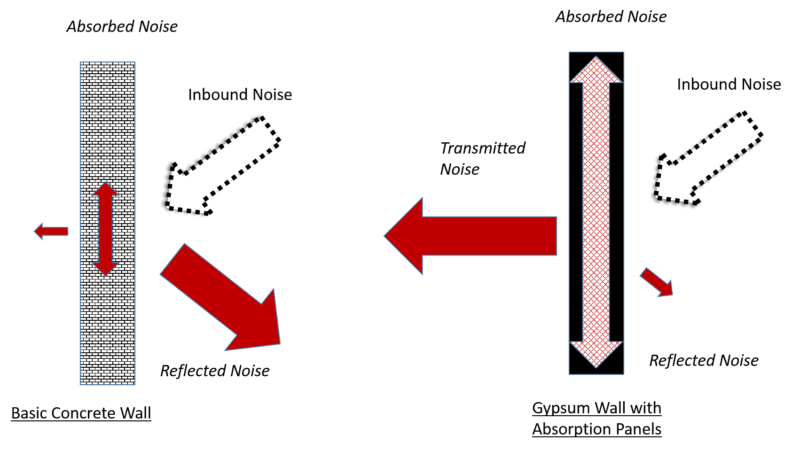There is a way to quantify how much sound is reflected in a room by using a metric called the absorption coefficient. In a nutshell, an Absorption Coefficient is a measure of how much sound is absorbed, and NOT reflected.
What is Sound Absorption?
Acoustic Absorption is the process of turning the motion of air particles into heat. This is accomplished by transferring the movement of those particles into another material, as the air impacts a surface. If no surfaces are encountered, then the sound is slowly absorbed by the atmosphere.
How Much Sound Absorption Do I Need?
Hard, reflective surfaces absorb very little of the sound energy that impacts them. Examples of these are metal, wood, concrete, and glass.

Absorption is best accomplished by soft, porous materials. These can include common finishes (curtains, carpets and rugs, ceiling tiles) or specialty acoustic treatments (acoustic panels, ceiling clouds, baffles, stretched fabric walls), or a combination of the two.
The larger the size of a space, the longer amount of time it takes for sound to hit the surrounding surfaces after each reflection. Since the surfaces absorb most of the sound, this means that it will take longer for sound to die down in a space with large areas and high ceilings.
Room Acoustics models depend on both the size of the room, as well as the finishes.
By understanding the principles of Acoustic Absorption, you may design a space that is acoustically pleasant and that will meet and exceed the reverberation requirements demanded by many clients.
Key Sound Absorption Terms
- Absorption: When sound is absorbed, it is really the kinetic energy of the sound wave being transferred to heat energy. You cannot feel the heat energy, typically, but as the sound is absorbed and converted, the sound level in the room dissipates.
- Echo: A sound reflection of 1.5 seconds or longer, such that the initial sound has completely decayed and the reflected sound is heard distinctly
- Reverberation: Event when a signal or impulse noise is reflected off of a number of surfaces, and then decays as it is absorbed into objects in the space (including air, walls, furniture, and drapery).
What is a Good Sound Absorption Coefficient?
The absorption coefficient ranges between zero and one, one meaning no sound energy is reflected and the sound is either absorbed or transmitted. For example, an opened exterior window has the absorption coefficient of one because no sound returns to the room. An effective absorber will have a sound absorption coefficient greater than .75.
If there is an excessive reverberance absorbing material should be added to decrease it. Materials that are more porous, less smooth, of less weight, thicker porous material, mounted over an airspace, or of less mass where more energy converts to mechanical energy, have higher values of the absorption coefficient.

In the above picture, arrows are coordinated to represent the difference between the sound absorbed in a basic concrete wall in comparison with a gypsum wall with absorption panels. The arrows were purposely increased or decreased in size to show the difference. In the basic concrete wall, it is clearly shown that sound is reflected much more than the one with absorption panels. On the contrary, the transmitted noise increased with the absorption panels benefiting communication in a room.

